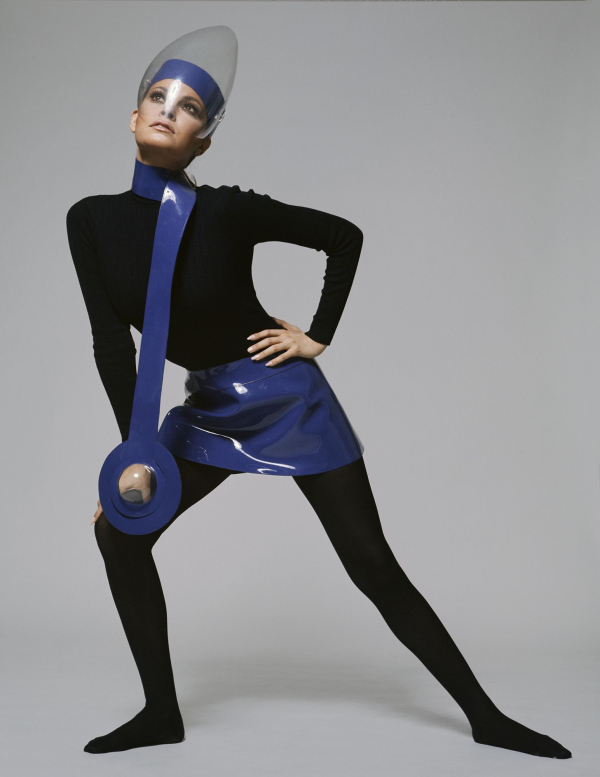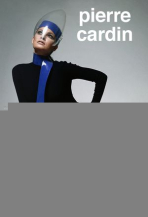
Terry O'Neill (British, born 1938). Raquel Welch in a Pierre Cardin outfit featuring a miniskirt and necklace in blue vinyl, worn with a Plexiglas visor, 1970. Image courtesy of Iconic Images. © Terry O’Neill / Iconic Images

Terry O'Neill (British, born 1938). Raquel Welch in a Pierre Cardin outfit featuring a miniskirt and necklace in blue vinyl, worn with a Plexiglas visor, 1970. Image courtesy of Iconic Images. © Terry O’Neill / Iconic Images

Pierre Cardin “Cosmocorps” suits and “Porthole” dresses, 1968. (Photo: Yoshi Takata. Courtesy of Archives Pierre Cardin. © Archives Pierre Cardin)

Eddie Adams (American, 1933–2004). Pierre Cardin, 1974. Chromogenic photograph on paper, 111/4 x 15 in. (28.6 x 38.1 cm). National Portrait Gallery, Smithsonian Institute; gift of Time magazine, Briscoe Center for American History, NPG.78.TC276. © Estate of Eddie Adams. (Photo: Courtesy of National Portrait Gallery)

Lauren Bacall, Leslie Bogart, and Alain Delon at Pierre Cardin's Fall 1968 fashion show. (Photo: Courtesy of Archives Pierre Cardin. © Archives Pierre Cardin)
In 1968 American actor Lauren Bacall attended Pierre Cardin’s Fall show, which featured his newly realized dresses, made from Cardine—Cardin’s specially spun, heat-molded Dynel acrylic fabric.
Bacall was taking note of the newest fashions as homework for her upcoming CBS fashion special Bacall and the Boys. The 52-minute program aired on August 24, 1968, and featured Cardin, Marc Bohan for Dior, Emanuel Ungaro, and Yves Saint Laurent.

Pierre Cardin dress with kinetic back, 1970. (Photo: Yoshi Takata. Courtesy of Archives Pierre Cardin. © Archives Pierre Cardin)
Cardin’s 1970 “Kinetic” dress is composed of a series of U-shaped panels that cascade from the shoulders and swing like pendulums as the wearer moves. Just as artists such as László Moholy-Nagy, Alexander Calder, and George Rickey made sculptures that changed form as the wind moved about them, Cardin saw the model as the armature for the garment, which metamorphosed into unique sculptural forms, whether the wearer was walking or dancing.

Pierre Cardin in his couture salon, 1952. (Photo: Courtesy of Archives Pierre Cardin. © Archives Pierre Cardin)

Pierre Cardin linen pants, 1972. (Photo: courtesy of Archives Pierre Cardin. © Archives Pierre Cardin)

Pierre Cardin at work, 1968. (Photo: Courtesy of Archives Pierre Cardin. © Archives Pierre Cardin)

Pierre Cardin “Junior Unit” chest, 1979–80. Chrome-plated metal, lacquered wood. (Photo: Courtesy of Archives Pierre Cardin. © Archives Pierre Cardin)

Pierre Cardin two-tone jersey dresses, with vinyl waders, 1969. (Photo: Yoshi Takata. © Pierre Pelegry)

Pierre Cardin wearing Apollo 11 space suit, 1969. (Photo: Courtesy of Archives Pierre Cardin. © Archives Pierre Cardin)

Presentation of Pierre Cardin’s Spring 2017 collection at the Yellow River Stone Forest National Geological Park in Baiyin, China, 2016. (Photo: Courtesy of Archives Pierre Cardin. © Archives Pierre Cardin)
Throughout Cardin’s career, his fashion shows were often noted for their scale. In 1960, to introduce his first men’s collection, the “Cylinder” line, he presented the suits on 250 college students. In the 1970s, he took to narrating the presentations, which could exceed an hour and a half.
Andy Warhol described one such presentation in a diary entry for October 6, 1980: “C.Z. [Guest] took the station wagon and drove us to the Met to the Cardin fashion show dinner. It was the longest fashion show in the world. I was so surprised. I think he’s kept every dress he ever made, there were so many of them. . . . I saw Pierre Cardin at the end and told him his show was great—I did like it because he’d kept so many dresses, from 1950–1980.”
In China, Cardin’s fashion shows grew to operatic scale, staged in extravagantly lavish settings: the Gobi Desert, the Yellow River Stone Forest, and the Great Wall of China.

Models wearing Pierre Cardin “Pagoda” jackets in China, 1979. (Photo: Courtesy of Archives Pierre Cardin. © Archives Pierre Cardin)
Pierre Cardin: Future Fashion
July 20, 2019–January 5, 2020
Pierre Cardin: Future Fashion is the first New York retrospective in forty years to focus on the legendary couturier. Drawn primarily from Pierre Cardin’s archive, the exhibition traverses the designer’s decades-long career at the forefront of fashion invention. Known today for his bold, futuristic looks of the 1960s, 1970s, and 1980s, Cardin extended his design concepts from fashion to furniture, industrial design, and beyond.
The exhibition presents over 170 objects drawn from his atelier and archive, including historical and contemporary haute couture, prêt-à-porter, trademark accessories, “couture” furniture, lighting, fashion sketches, personal photographs, and excerpts from television, documentaries, and feature films. The objects are displayed in an immersive environment inspired by Cardin’s unique atelier designs, showrooms, and homes.
Highlights of Pierre Cardin: Future Fashion include rare designs in luxury fabrics from the 1950s; a large grouping from the landmark 1964 “Cosmocorps” collection, which sought to streamline menswear by eliminating excessive detailing; creations that incorporate vinyls, plastics, and the self-named Cardine synthetic fabric; signature unisex ensembles featuring full knit bodysuits with layered skirts, vests, bibs, and jewelry; iconic broad-shouldered jackets from the 1980s based on Japanese origami, Chinese architecture, and American football uniforms; “illuminated” jumpsuits and dresses; recent couture eveningwear; and an extensive overview of Cardin’s recently designed couture menswear.
Pierre Cardin: Future Fashion is curated and designed by Matthew Yokobosky, Senior Curator of Fashion and Material Culture, Brooklyn Museum.

